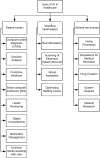Conceptualising Artificial Intelligence as a Digital Healthcare Innovation: An Introductory Review
- PMID: 32904333
- PMCID: PMC7455610
- DOI: 10.2147/MDER.S262590
Conceptualising Artificial Intelligence as a Digital Healthcare Innovation: An Introductory Review
Abstract
Artificial intelligence (AI) is widely recognised as a transformative innovation and is already proving capable of outperforming human clinicians in the diagnosis of specific medical conditions, especially in image analysis within dermatology and radiology. These abilities are enhanced by the capacity of AI systems to learn from patient records, genomic information and real-time patient data. Uses of AI range from integrating with robotics to creating training material for clinicians. Whilst AI research is mounting, less attention has been paid to the practical implications on healthcare services and potential barriers to implementation. AI is recognised as a "Software as a Medical Device (SaMD)" and is increasingly becoming a topic of interest for regulators. Unless the introduction of AI is carefully considered and gradual, there are risks of automation bias, overdependence and long-term staffing problems. This is in addition to already well-documented generic risks associated with AI, such as data privacy, algorithmic biases and corrigibility. AI is able to potentiate innovations which preceded it, using Internet of Things, digitisation of patient records and genetic data as data sources. These synergies are important in both realising the potential of AI and utilising the potential of the data. As machine learning systems begin to cross-examine an array of databases, we must ensure that clinicians retain autonomy over the diagnostic process and understand the algorithmic processes generating diagnoses. This review uses established management literature to explore artificial intelligence as a digital healthcare innovation and highlight potential risks and opportunities.
Keywords: artificial intelligence; data; diagnostic algorithms; innovation; machine learning.
© 2020 Arora.
Conflict of interest statement
The author reports no conflicts of interest in this work.
Figures


References
-
- Paschen U, Pitt C, Kietzmann J. Artificial intelligence: Building blocks and an innovation typology. Bus Horiz. 2019. doi:10.1016/j.bushor.2019.10.004 - DOI
-
- European Commission [Internet]. Re-Finding Industry: Report from the High-Level Strategy Group on Industrial Technologies. Publications Office of the EU; 2018. Available from: https://ec.europa.eu/research/industrial_technologies/pdf/re_finding_ind.... Accessed 12April 2020.
-
- US Food and Drug Administration [Internet]; January 2020. Available from: https://www.fda.gov/medical-devices/software-medical-device-samd/artific.... Accessed April13, 2020.
Publication types
LinkOut - more resources
Full Text Sources
Research Materials

